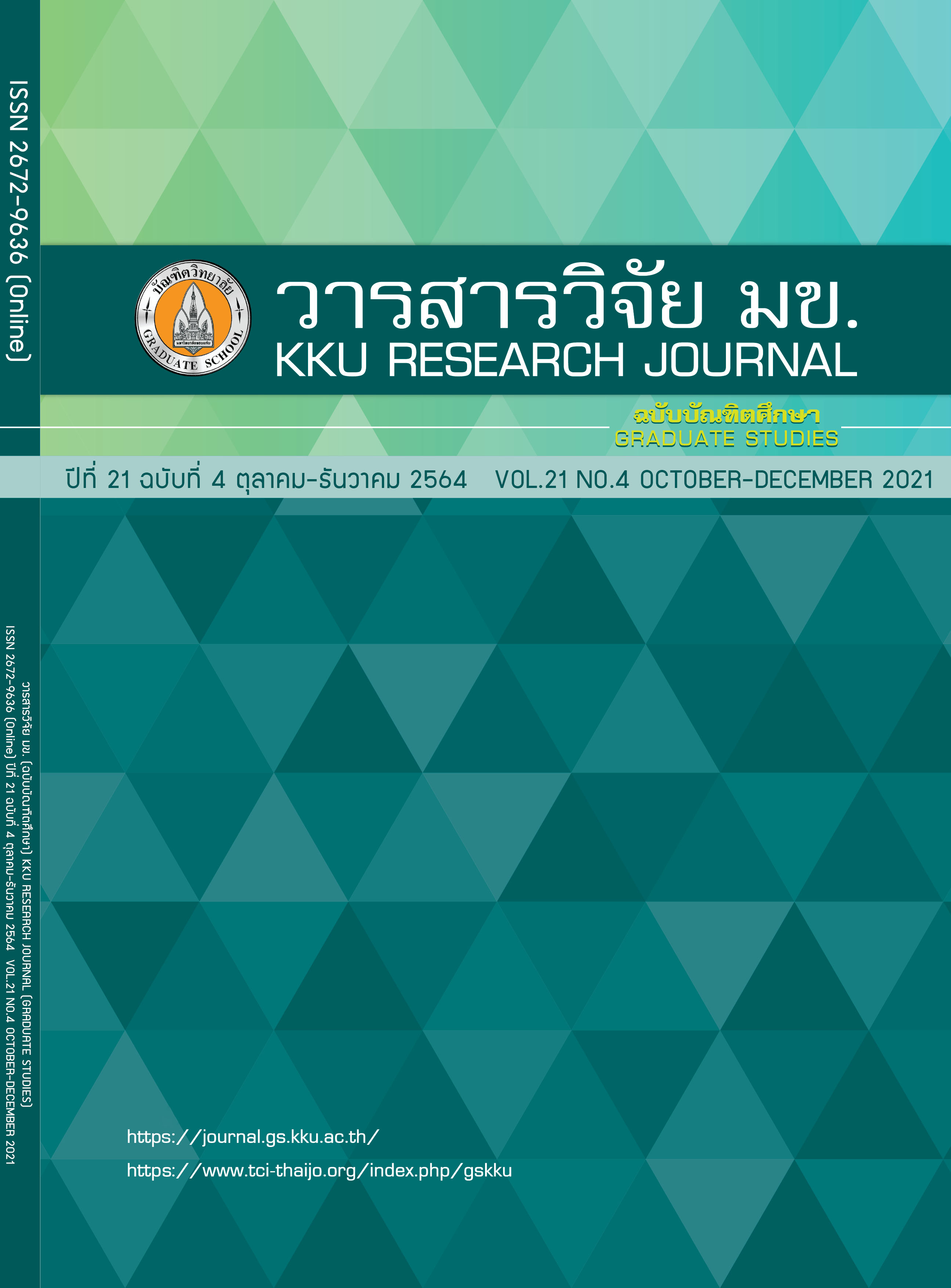Depolymerization of Lignin using Water and Ethanol Solvents to Synthesize Lignin Resole for Preparing Lignin Foam
Keywords:
Bio-foam, Depolymerization, Phenol foamAbstract
In this study, lignin was used as substitution phenol for synthesis lignin foam. The depolymerizations of lignin by water (LS-W) and ethanol solutions (LS-ETH) were used as components for preparing lignin resole (LR) and forming lignin foam (LF). The LS-W and LS-ETH depolymerized lignin solutions with different lignin contents were determined concentration of phenol with reaction times of 30 and 60 min. The solution with the highest concentration of phenol was applied for LR synthesis and LF preparation. From results, the highest phenol concentration of 1644 ppm was obtained in the LS-ETH with 30.61%wt of lignin at the reaction time of 30 min. Each depolymerized lignin solutions with lignin was used as 15 wt% substitute of phenol to synthesize LR for LF preparation. The FTIR analysis of LR and LF showed the same functional group and chemical structure as the phenol foam (PF). The density and compressive strength were 85.68 kg/m3 and 152.27 kPa for the LF from LS-W, and were 70.19 kg/m3 and 113.71 kPa for the LF from LS-ETH, respectively. The SEM morphology revealed that the foams had a closed-cell structure.
References
American Society for Testing and Materials (ASTM C1126) Standard Specification for Faced or Unfaced Rigid Cellular Phenolic Thermal Insulation. 2009 :1-5.
Li B, Wang Y, Mahmood N, Yuan Z, Schmidt J, (Charles) Xu C. Preparation of bio-based phenol formaldehyde foams using depolymerized hydrolysis lignin. Ind Crops Prod. 2017; 97: 409–416.
Shen H, Nutt S. Mechanical characterization of short fiber reinforced phenolic foam. Composites Part A: Applied Science and Manufacturing. 2003; 34(9): 899–906.
Li Y, Ragauskas AJ. Kraft Lignin-Based Rigid Polyurethane Foam. Journal of Wood Chemistry and Technology. 2012; 32(3): 210–224.
Li B, Zhou M, Huo W, Cai D, Qin P, Cao H, et al. Fractionation and oxypropylation of corn-stover lignin for the production of biobased rigid polyurethane foam. Industrial Crops and Products. 2020; 143: 111887.
Mwamatope B, Tembo D, Chikowe I, Kampira E, Nyirenda C. Total phenolic contents and antioxidant activity of Senna singueana, Melia azedarach, Moringa oleifera and Lannea discolor herbal plants. Scientific African. 2020; 9: e00481.
Zhang W, Ma Y, Wang C, Li S, Zhang M, Chu F. Preparation and properties of lignin–phenol–formaldehyde resins based on different biorefinery residues of agricultural biomass. Industrial Crops and Products. 2013; 43: 326–333.
Kirk TK, Farrell RL. Enzymatic “Combustion”: The Microbial Degradation of Lignin. Annual Review of Microbiology. 1987; 41(1): 465–501.
Leephisuth P, Sriprom P, Neramittagapong S, Neramittagapong A. Optimization of Lignin Degradation to Phenol Using Wet Oxidation Under Mild Condition. KKU Res J. 2020; 20(1): 90-101. Thai.
Sangnak S, Sriprom P, Neramittagapong A, Neramittagapong S. Degradation of Lignin to High Value-Added Compounds Using Hydrothermal Method Over Ni/Al2O3 Catalyst. KKU Res J. 2015; 15(4): 36–44. Thai.
Wang G, Liu X, Zhang J, Sui W, Jang J, Si C. One-pot lignin depolymerization and activation by solid acid catalytic phenolation for lightweight phenolic foam preparation. Industrial Crops and Products. 2018;124: 216–225.
American Society for Testing and Materials (ASTM D1622) Standard Test Method for Apparent Density of Rigid Cellular Plastics. 2004; 14: 3–6.
American Society for Testing and Materials (ASTM D1621) Standard test method for compressive properties of rigid cellular plastics. 1991 :1621–1673.
Ouyang X, Ruan T, Qiu X. Effect of solvent on hydrothermal oxidation depolymerization of lignin for the production of monophenolic compounds. Fuel Process Technol. 2016; 144: 181–185.
Kifer EW, Colton JP, Stickel JT. Closed cell phenolic foam containing alkyl glucosides. United States patent US 4956394. 1990 Sep 11.
Li B, Feng SH, Niasar HS, Zhang YS, Yuan ZS, Schmidt J, et al. Preparation and characterization of bark-derived phenol formaldehyde foams. RSC Advances. 2016; 6(47): 40975–81.
Paysepar H, Hu Y, Feng S, Yuan Z, Shui H, (Charles) Xu C. Bio-phenol formaldehyde (BPF) resoles prepared using phenolic extracts from the biocrude oils derived from hydrothermal liquefaction of hydrolysis lignin. Reactive and Functional Polymers. 2020; 146: 104442.
Poljanšek I, Šebenik U, Krajnc M. Characterization of phenol-urea-formaldehyde resin by inline FTIR spectroscopy. Journal of Applied Polymer Science. 2006; 99(5): 2016–2028.
Abdelaziz O, Hulteberg C. Physicochemical Characterisation of Technical Lignins for Their Potential Valorisation. Waste and Biomass Valorization. 2016;
Tejado A, Peña C, Labidi J, Echeverria JM, Mondragon I. Physico-chemical characterization of lignins from different sources for use in phenol–formaldehyde resin synthesis. Bioresource Technology. 2007; 98(8): 1655–1663.
Alriols MG, Tejado A, Blanco M, Mondragon I, Labidi J. Agricultural palm oil tree residues as raw material for cellulose, lignin and hemicelluloses production by ethylene glycol pulping process. Chemical Engineering Journal. 2009; 148(1): 106–114.
Cheng S, D’Cruz I, Yuan Z, Wang M, Anderson M, Leitch M, et al. Use of Biocrude Derived from Woody Biomass to Substitute Phenol at a High-Substitution Level for the Production of Biobased Phenolic Resol Resins. Journal of Applied Polymer Science. 2011; 121: 2743–2751.
Boukir A, Fellak S, Doumenq P. Structural characterization of Argania spinosa Moroccan wooden artifacts during natural degradation progress using infrared spectroscopy (ATR-FTIR) and X-Ray diffraction (XRD). Heliyon. 2019; 5(9): e02477.
Ren X, Cai H, Du H, Chang J. The Preparation and Characterization of Pyrolysis Bio-Oil-Resorcinol-Aldehyde Resin Cold-Set Adhesives for Wood Construction. Polymers. 2017; 9: 232.
Santos OSH, Coelho da Silva M, Silva VR, Mussel WN, Yoshida MI. Polyurethane foam impregnated with lignin as a filler for the removal of crude oil from contaminated water. Journal of Hazardous Materials. 2017; 324: 406–413.
Wells T, Kosa M, Ragauskas AJ. Polymerization of Kraft lignin via ultrasonication for high-molecular-weight applications. Ultrasonics Sonochemistry. 2013; 20(6): 1463–1469.
Hu L, Zhou Y, Zhang M, Liu R. Characterization and properties of a lignosulfonate-based phenolic foam. Bioresources. 2011;7.
Li B, Yuan Z, Schmidt J, (Charles) Xu C. New foaming formulations for production of bio-phenol formaldehyde foams using raw kraft lignin. European Polymer Journal. 2019; 111: 1–10.
Jalalian M, Jiang Q, Coulon A, Storb M, Woodward R, Bismarck A. Mechanically whipped phenolic froths as versatile templates for manufacturing phenolic and carbon foams. Materials & Design. 2019; 168: 107658.



